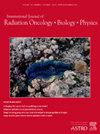O-GlcNAcylation of PRDX1 and Radiation Resistance in Non-Small Cell Lung Cancer via Suppressing TRIM21 Mediated Ubiquitination
IF 6.4
1区 医学
Q1 ONCOLOGY
International Journal of Radiation Oncology Biology Physics
Pub Date : 2024-10-01
DOI:10.1016/j.ijrobp.2024.07.041
引用次数: 0
Abstract
Purpose/Objective(s)
The molecular mechanism underlying radiation resistance in non-small cell lung cancer (NSCLC) is not well understood. This study aimed to investigate the potential role of Peroxiredoxin-1 (PRDX1) O-GlcNAcylation and its specific regulatory mechanism in NSCLC radiotherapy resistance.
Materials/Methods
To establish radiotherapy-resistant NSCLC cell lines, multiple radiotherapy treatments were administered. The radiosensitivity of cells was evaluated using colony formation assay, western blot, and immunofluorescence. Metabolic changes in response to irradiation challenge were comprehensively analyzed through a metabolomics assay comparing radioresistant NSCLC cell lines (A549R or LLCR) with their parental cell lines (A549 or LLC). The correlation between PRDX1 and O-GlcNAcylation expression was investigated using a tissue microarray (TMA) of human NSCLC tissue (n = 90). Co-immunoprecipitation coupled with mass spectrometry (Co-IP-MS) was employed to identify proteins regulating PRDX1 expression. The functional role of PRDX1 O-GlyNAcylation in NSCLC radiotherapy resistance was validated through multicolor immunofluorescence staining in tissue samples from pre-radiotherapy biopsies (n = 79). Lastly, a short peptide was designed to target PRDX1 glycosylation both in vitro and in vivo.
Results
Metabolomic analyses revealed a shift in metabolic flux to the hexosamine biosynthesis pathway (HBP) with higher levels of UDP-GlcNAc in radioresistant NSCLC cells, a substrate for O-GlcNAcylation. Subsequently, O-GlcNAcylation and PRDX1 were found to be significantly up-regulated in human NSCLC tissues compared to adjacent benign tissues. O-GlcNAcylation of PRDX1, mediated by OGT, was identified as critical for radioresistance in NSCLC. Specifically, PRDX1 was O-GlcNAcylated at the conserved serine 2/3, and radiation-resistant NSCLC cells exhibited elevated levels of O-GlcNAcylation of PRDX1. This post-translational modification protected the protein stability of PRDX1, while TRIM21 was discovered as an E3 ubiquitin ligase promoting PRDX1 degradation, with its interaction affected by O-GlcNAcylation. Conversely, pharmacological reduction in the O-GlcNAcylation of PRDX1 (OSMI treatment) enhanced the radiotherapy sensitivity of NSCLC. Notably, multicolor immunofluorescence staining of tissue samples from pre-radiotherapy biopsies (n = 79) confirmed a positive correlation between PRDX1 O-GlyNAcylation levels and OGT expression, as well as radiotherapy tolerance, and a negative correlation with TRIM21 expression levels.
Conclusion
Our findings highlight the regulatory role of PRDX1 in NSCLC radiation resistance, emphasizing how O-GlcNAcylation stabilizes and shields PRDX1 from TRIM21-mediated ubiquitination. These results uncover a potential mechanism of NSCLC radiation resistance and propose a promising therapeutic approach for NSCLC treatment.
通过抑制 TRIM21 介导的泛素化,PRDX1 的 O-GlcNAcylation 与非小细胞肺癌的抗辐射能力
目的 非小细胞肺癌(NSCLC)放射治疗耐药性的分子机制尚不十分清楚。本研究旨在探讨过氧化物酶-1(Peroxiredoxin-1,PRDX1)O-GlcNAcylation在NSCLC放疗耐药性中的潜在作用及其特定调控机制。使用集落形成试验、Western印迹和免疫荧光评估细胞的放射敏感性。通过代谢组学检测,全面分析了抗放射治疗的NSCLC细胞系(A549R或LLCR)与其亲本细胞系(A549或LLC)在接受辐照挑战后的代谢变化。利用人类 NSCLC 组织(n = 90)的组织芯片(TMA)研究了 PRDX1 和 O-GlcNAcylation 表达之间的相关性。采用共免疫沉淀结合质谱法(Co-IP-MS)鉴定了调控 PRDX1 表达的蛋白质。通过对放疗前活检组织样本(79 例)进行多色免疫荧光染色,验证了 PRDX1 O-GlyNAcylation 在 NSCLC 放疗耐药性中的功能作用。结果代谢组学分析表明,放射耐药性NSCLC细胞中的代谢通量转向了己胺生物合成途径(HBP),UDP-GlcNAc水平更高,而UDP-GlcNAc是O-GlcNAcylation的底物。随后发现,与邻近的良性组织相比,O-GlcNAcylation 和 PRDX1 在人类 NSCLC 组织中明显上调。OGT介导的PRDX1的O-GlcNAcylation被认为是NSCLC放射抗性的关键。具体来说,PRDX1在保守的丝氨酸2/3处被O-GlcNAcyl化,耐辐射的NSCLC细胞表现出PRDX1的O-GlcNAcyl化水平升高。这种翻译后修饰保护了 PRDX1 蛋白的稳定性,同时发现 TRIM21 是促进 PRDX1 降解的 E3 泛素连接酶,其相互作用受 O-GlcNAcylation 的影响。相反,药物减少 PRDX1 的 O-GlcNAcylation (OSMI 治疗)可提高 NSCLC 的放疗敏感性。值得注意的是,对放疗前活检组织样本(n = 79)进行的多色免疫荧光染色证实,PRDX1 O-GlcNAcylation水平与OGT表达以及放疗耐受性呈正相关,而与TRIM21表达水平呈负相关。这些结果揭示了 NSCLC 耐辐射性的潜在机制,并为 NSCLC 治疗提出了一种前景广阔的治疗方法。
本文章由计算机程序翻译,如有差异,请以英文原文为准。
求助全文
约1分钟内获得全文
求助全文
来源期刊
CiteScore
11.00
自引率
7.10%
发文量
2538
审稿时长
6.6 weeks
期刊介绍:
International Journal of Radiation Oncology • Biology • Physics (IJROBP), known in the field as the Red Journal, publishes original laboratory and clinical investigations related to radiation oncology, radiation biology, medical physics, and both education and health policy as it relates to the field.
This journal has a particular interest in original contributions of the following types: prospective clinical trials, outcomes research, and large database interrogation. In addition, it seeks reports of high-impact innovations in single or combined modality treatment, tumor sensitization, normal tissue protection (including both precision avoidance and pharmacologic means), brachytherapy, particle irradiation, and cancer imaging. Technical advances related to dosimetry and conformal radiation treatment planning are of interest, as are basic science studies investigating tumor physiology and the molecular biology underlying cancer and normal tissue radiation response.

 求助内容:
求助内容: 应助结果提醒方式:
应助结果提醒方式:


